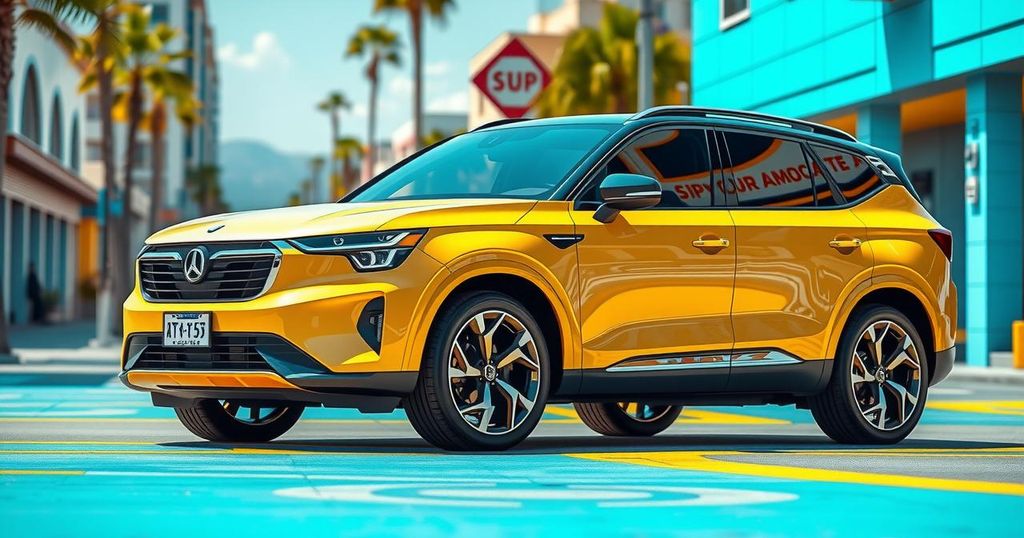Chevrolet vs China: The Future of Uzbekistan’s Automotive Industry
This article explores the changing dynamics of Uzbekistan’s auto industry, dominated by Chevrolet vehicles for decades. The rise of Chinese electric vehicles is challenging this monopoly as the country embraces market reforms. Despite Silverado’s historical presence and the industrial foundation it provided, evolving consumer preferences and government initiatives suggest an impending shift towards electric mobility.
In Uzbekistan, a notable phenomenon is the overwhelming presence of Chevrolet vehicles, primarily white, dominating the automotive landscape. Alisher, a local driver, noted that nearly 90% of cars are Chevrolets, with 80% of those being white. However, this dominant period may be shifting as the global electric vehicle (EV) revolution gains traction, propelling Chinese manufacturers to challenge Chevrolet’s long-standing supremacy.
Islam Karimov, Uzbekistan’s inaugural president, notably leveraged his economic expertise by forging a partnership with South Korean conglomerate Daewoo in 1996 to establish the nation’s first automobile factory. Following Daewoo’s sale to General Motors in 2002, vehicles were produced under the Chevrolet brand, resulting in limited automotive variety on local roads dominated by Chevrolet and aging Soviet models. This monopoly, despite offering limited choices, helped build a domestic industrial base and provide jobs.
Since the death of President Karimov in 2016, his successor Shavkat Mirziyoyev has embraced market reforms. This policy shift has facilitated an influx of foreign brands, particularly from South Korea and China. In 2019, the government eliminated tariffs on imported EVs, significantly buoying the industry, culminating in a joint venture between state-owned UzAuto Motors and China’s BYD, which is anticipated to produce approximately 50,000 vehicles annually.
Despite the introduction of new brands and models, the prevalence of Chevrolets remains stark, particularly in regions outside the capital. For instance, in Andijan, a survey indicated that 95.5% of vehicles are Chevrolets. Alisher expressed concerns regarding the cost of electric vehicles, highlighting expensive service and maintenance issues associated with EVs compared to the readily available parts for Chevrolets.
This maintenance accessibility is a significant factor favoring Chevrolet, as mechanics are well-trained in working with these vehicles. Alisher noted that many people opt to modify their Chevrolet engines for more cost-effective fuel solutions, which further complicates the potential adoption of EVs.
However, indications suggest a gradual shift towards electric vehicles. Sherzod Yuldashev, a business development expert, pointed out that consumer attitudes are evolving as the sales of EVs increase annually. Experts agree that the market’s adaptation for servicing electric vehicles is progressing, with consumers gaining access to more support options, even for brands like Tesla.
Moreover, as economies of scale for EV production develop, pricing for electric vehicles is expected to decrease, potentially making them more accessible. There are even Chinese-made EVs available starting at around $15,000. Concurrently, Chevrolet faces challenges with its product line, diminishing interest in older models, and the struggle to introduce new competitive vehicles.
In a bid to regulate the growing import market dominated by cheaper vehicles, the government has also implemented several non-tariff barriers, including costly compliance checks on imported EVs. Despite these protective measures, the rapid and comprehensive growth of the Chinese EV sector renders significant resistance to their market entry unlikely.
In light of these market dynamics, many consumers are enjoying increased alternatives, prompting Chevrolet to reduce prices and adapt. Farkhodjon Israilov remarked on this market reality, noting the competitive landscape’s evolution, as domestic manufacturers are compelled to respond to altering consumer demands.
The automotive landscape in Uzbekistan is undergoing a significant transformation, with Chinese electric vehicles challenging Chevrolet’s longstanding dominance. Though Chevrolet has historically provided job security and a robust industrial framework, recent governmental reforms and evolving consumer preferences suggest a gradual shift towards electric vehicles. As market dynamics continue to evolve, consumers are benefiting from increased choices and competitive pricing, highlighting the inevitable changes within Uzbekistan’s auto industry.
Original Source: timesca.com




Post Comment